Thoughts for Tuesday: NoMa, sports-based development, Starchitects, and developer stratagems and realities of the market
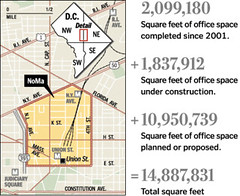 Development "Capacity" in NoMa. Washington Post graphic by Laris Karklis.
Development "Capacity" in NoMa. Washington Post graphic by Laris Karklis.Yesterday's Post has an article, "Coming Soon to NoMa: Life," about "NoMa" the North of Massachusetts area that is east of downtown and north of Union Station.
1. The subtitle of the article is "With Little Land Available Downtown, Developers Look East."
This is an important point that I make all the time about that big project known as "MCI Center." Once the local political structure became less risky, Downtown's "East End" would have developed anyway, with or without the Arena, because of the lack of inventory of developable land in the more western part of the Central Business District.
It is true that MCI Center (along with the election of Anthony Williams as Mayor) changed the perception of risk in the real estate investment climate and increased the amount of "sampling" of Downtown (and DC) by suburbanites attending events at the MCI Center. But just like NoMA, developers would have come to this area sooner or later out of "necessity" --their need to have land inventory to develop. (You can't be a developer if you don't continue to build projects...)
This is a function of the height restrictions (which I don't complain about), which makes DC a market of relatively small, squat office buildings, with a much smaller inventory of leasable commercial space, compared to cities that have "skyscrapers"--or bigger buildings generally. E.g., the old May Department Store on Euclid Avenue in Cleveland is 1 million square feet. The average DC office building is much smaller.
I will agree that development of the East End likely occured faster as a result of the MCI Center, but it is hard to say.
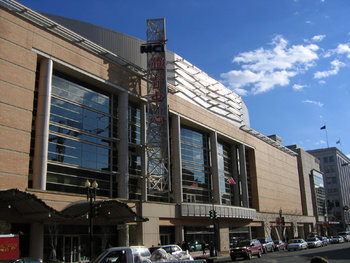 The MCI Center was built and paid for by Abe Pollin, owner of the Washington Wizards basketball team and the Washington Capitals hockey team.
The MCI Center was built and paid for by Abe Pollin, owner of the Washington Wizards basketball team and the Washington Capitals hockey team.2. Probably three years ago, I was with Kevin Palmer downtown during the work day and there were all these white families walking around with children. Turns out there was some child-oriented concert that day at the MCI Center. Clearly the people walking around weren't from DC. That is the kind of sampling of the city that I am referring to, the kind of exploration of the city that is promoted by having such facilities in the city.
(However, too often people come into the city, go directly to their intended destination, "consume" the event, and upon cessation of the event return immediately to their suburban abodes.)
But remember, that while DC did pay for road infrastructure and other upgrades in the area around the Arena, upgrades that benefit other people and projects besides the MCI Center, the Arena was paid for by the owner of the Wizards and Capitals sports teams, Abe Pollin.
SO the financial return to DC is likely much greater for MCI Center compared to the Baseball Stadium, because the amount of money "invested" by the City Government into the respective projects likely varies by a factor of five (5) -- meaning five times more money, perhaps as much as $1 Billion, will go into the baseball stadium. You need a lot of return to make such an investment worthwhile.
3. So the discussion about the economic development that will be augured by the baseball stadium has a familiar, but complicated and nuanced, ring.
It is difficult to separate out the fact that the District of Columbia only has 40 square miles or so of non-federal land that can be built upon. The Central Business District is only so big, and as long as legal and lobbying firms (plus associations) oriented to the federal government continue to grow, the "Central Business District" must grow east (first to the "East End," and now to "Mount Vernon Triangle" and "NoMa") and south (first in the area around the Navy Yard as a result of DoD consolidation and now the South Capitol corridor generally) to accommodate this inexorable expansion.
4. Will baseball bring the development to the Anacostia, or will it merely be a function of the availability of developable land?
Speaking of the Anacostia Waterfront, is it possible to have a successful "revitalization," that because the bulk of the work being done is in fact all new construction, it becomes a "redevelopment" -- with uniformly high rents, pricing out unique local businesses.
Last week I was reading the new draft comprehensive plan for Baltimore and I found interesting the fact that they have about a 40 page history of the city as part of the plan. However, parts of the pretty abbreviated post-1955 history read more like they have been written by business interests or the equivalent of a "Deputy Mayor for Economic Development," rather than an objective historian looking for fact-based explanations.
To wit, Baltimore is very proud, and they should be, of the success of the Inner Harbor. But even in their discussion of the history of it, they point out (again with pride) that virtually everything (not the "PowerPlant") that had been there before was demolished in favor of newly constructed pavilions and other attractions.
The Inner Harbor is on the water, and the Port of Baltimore and the Inner Harbor continue to be real, but much of what is in the Inner Harbor is fake. You might as well be at Disneyland. This is the point I make all the time about "authenticity." PowerPlant Live isn't authentic, even though I like the Barnes & Noble.
5. When I go to Baltimore, I would much rather go to Little Italy to see a movie on a Friday night in the summer, or go get dessert pizza at Brick Oven Pizza in Fells Point, look at the buildings and neighborhood commercial districts on Eastern Avenue (really Highlandtown), read (and buy) graphic novels at Atomic Books in Hampden, see a movie at the Charles Theater, or walk up from Inner Harbor along Charles Street to Penn Station, etc., then go to the Inner Harbor for a meal at California Pizza Kitchen.
Manufacturing experiences just to experience them, what Rouse did in the Inner Harbor, what Rick Caruso did at The Grove in LA with its fake one block trolley, and what the Cordish Company is doing around the country, and will be doing in DC, reminds me of George Luca's first movie THX-1138, where the world is underground and the prevailing architecture is a mix of airport design + shopping malls. It ain't real.
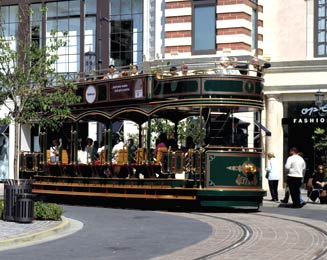 Consuming inauthentic experiences. The trolley at "The Grove." Photo from their website, which describes the trolley thusly:
Consuming inauthentic experiences. The trolley at "The Grove." Photo from their website, which describes the trolley thusly:- Built on an historic undercarriage from a 1950’s Boston street car, 35 feet long and 13 feet 4 ¾ inches tall
- Travels the ¼ mile track between The Grove and The Farmers Market in 6 minutes and 12 seconds
- Red oak running boards, custom-cast brass handrails and fittings, and two spiral staircases that lead to the upper deck
- Powered electrically by 52 12-volt batteries, The Grove Trolley is the first use of inductive power technology in the U.S. for a transit system.
Bringing more of these kinds of manufactured experiences to DC such as at Gallery Place (formerly known as Chinatown) does us no favors.
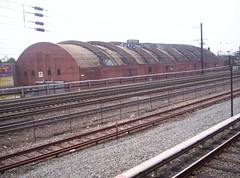 Uline Arena and the Union Station railyard.
Uline Arena and the Union Station railyard.6. Back to NoMA. At the very end of the article, Doug Jemal mentions that he has had Norman Foster design the appendages proposed for the top of the Uline Arena. I was the leader of the effort to landmark this building and while the hearing hasn't been held yet, there is a recognition on all sides that the application has merit and will go forward.
Filing the nomination prevented the building from being demolished, and likely benefited Jemal by reducing the price of the site before he bought it, a landmark nomination being an encumbrance on ultimate development potential of the site (unless you hire a starchitect maybe).
I'm not sure that I like glass boxes generally (it is the rare glass building box that ages gracefully) but I do see the choice of Sir Norman as the architect as a stratagem designed to "add just a spoonful of sugar" to what appears to be an untasteful idea.
7. Note that the strategy of choosing a "sexy" or "connected" architect to help bully through (grease the process) a somewhat grotesque development project was used by Louis Dreyfus Company with Station Place--they picked Kevin Roche to design the project, and Roche was a friend of J. Carter Brown, chair of the Commission on Fine Arts, the federal commission that would be reviewing and in some sense making the final decisions about the project.
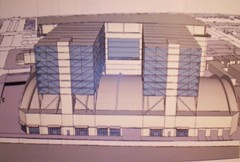 Norman Foster glass boxes proposed for the top of the Uline Arena, a building with a pending historic landmark designation. Rendering provided by the developer.
Norman Foster glass boxes proposed for the top of the Uline Arena, a building with a pending historic landmark designation. Rendering provided by the developer. 8. strat·a·gem (străt'ə-jəm) n. (Definition from answers.com)
1. A military maneuver designed to deceive or surprise an enemy.
2. A clever, often underhanded scheme for achieving an objective.
Index Keywords: baseball-stadiums; urban-revitalization;



0 Comments:
Post a Comment
<< Home